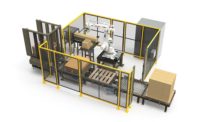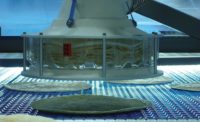Secondary packaging in the warehouse, a key component of the distribution chain, encompasses a wide range of machinery that performs shrink wrapping, shrink bundling, pallet unitizing and case building. Integrated palletizing and shrink-wrapping systems represent another end-of-line packaging solution that protects and delivers product to customers in a timely fashion. What’s more, the latest systems are able to meet demands of the quick-changing snack and bakery market.
Increased capabilities
“A growing number of bakery/snack plants are expanding their service areas and, as a result, there is a need for automated palletizing and shrink wrapping of products packed in regular slotted shipping cases (RCSs) and shrink-wrapped display trays,” says Sander Smith, product manager, Wexxar BEL, a brand of ProMach Inc., Covington, KY. “Plant managers are investing in automation to increase throughput and lower labor costs, while ensuring product protection during transit to distribution centers, club stores and supermarkets.
“Automating end-of-line distribution includes processes such as RCS forming and packing, printing and applying shipping labels, and palletizing and stretch-wrapping pallets loads,” continues Smith. “Display trays involve all of these operations—from packing to palletizing—with the inclusion of a shrink-wrap system.”
Reflecting the wide range of equipment in this sector, the ProMach family of end-of-line solutions includes: case formers, case erectors and case-sealing systems; tray formers; case and tray packing and robotic solutions; palletizers; automated shrink wrap systems; automated shrink bundle systems; and stretch wrapping and pallet unitizing systems.
The latest equipment features include human machine interface (HMI) technology with multi-lingual capabilities that mimic smartphone navigation for greater ease of use. End-of-line systems also support today’s diverse workforce by offering pictographs that communicate key adjustments to machine operators.
Stretch wrapping for bakery/snack products is mainly used to protect goods from dust or environmental aggression, to keep boxes together by containing the product and locking the layers to each other, and to attach the load itself to the bottom pallet to prevent shifting and to facilitate manipulation, according to Priscille Tremblay, sales director, Wulftec/M.J. Maillis, Ayer’s Cliff, Quebec. “Stretch film is clear, so you can see the product. The film also can be printed on to display logos or product information. It also can feature different colors to facilitate identification.”
Wulftec/M.J. Maillis has developed a stretch-wrapping system for distribution centers. It consists of one or more rotary-arm stretch wrappers that allow operators to move pallets of packaged goods through the system with a single, double or triple pallet jack. The operator can then select pre-set wrap patterns adapted to different products, ensuring proper load security and containment.
“What makes this system interesting is the fact that when using dual or triple pallet jacks, the operator can load and wrap two or three pallets simultaneously, therefore increasing throughput while reducing forklift or pallet jack traffic,” Tremblay says.
Lantech, Jeffersontown, KY, has introduced the QL-400XT semi-automatic stretch wrapper, which produces safe-to-ship profiles quickly for a variety of load configurations. It automatically captures the stretch film and cuts it at the end of the wrap cycle—saving two minutes of fork lift driver labor per load.
Lantech’s Load Guardian intelligent control system features interactive, highly responsive applications that simplify the building of wrap profiles, thus minimizing the need for operators to physically interact with the machine. Customized settings can be made quickly via a smartphone. In addition, an Intelligent Wrap feature helps the operator select characteristics of the load, producing an optimized wrap pattern for safe, cost-effective shipment.
ARPAC LLC, Schiller Park, IL, recently introduced the Zero Edge Sealer. Designed for longitudinal sealing of horizontal packaging equipment, it requires less film and has fewer mechanical components than existing systems, according to Ray Uttaro, horizontal product manager.
ARPAC also has introduced the ECO Series Shrink Tunnel, which is designed to lower energy costs. “In the past, shrink-tunnel designs were either energy efficient—slow to heat up, but consuming low amounts of energy to maintain heat—or they heated up quickly and required high levels of energy consumption. We have reengineered the way air is heated and how it flows within the heat chamber. The tunnel heats up in seconds and maintains heat economically,” Uttaro explains.
Combined solutions
New palletizers can easily mesh with, or feed into, stretch wrapping equipment. One way is to use roller conveyors to deliver full pallets to stretch wrappers. This option allows multiple palletizers to feed one stretch wrapper. In addition, it allows palletizers to run when stretch wrappers go down or vice versa. The second option is to integrate a stretch wrapper with a palletizer. This allows the palletizer and stretch-wrapper combination to use one control platform, which reduces setup and changeover time, as well as floor space requirements.
Columbia Machine, Vancouver, WA, has introduced the FL6200SW palletizer with an integrated stretch wrapper, which is designed to secure loads that are potentially unstable, or for operations that have space constraints. “The machine simultaneously stacks and stretch wraps a wide variety of the more-challenging package types we’re seeing more of these days—unwrapped trays, shrink pads and film-only bundles,” says Ted Yeigh, sales director.
Not only does the FL6200SW utilize servo control technology with a high-speed turntable and stretch wrapper that handles 100 cases per minute, it can be used with OTTO Motors’ self-driving vehicles (SDVs), which feature a payload capacity of 3,400 pounds, according to Yeigh. To optimize load stability, the FL6200SW can wrap each layer on the pallet concurrently—as the load is being built—without impacting palletizer throughput.
“With more companies implementing multiple pack lines with fewer workers, SDVs offer a more-flexible means to transport loads to a palletizer, or from an array of palletizers to a single stretch wrapper. Previously, unless they were using operators with pallet jacks, companies had to install a transfer cart on rails that was guarded to protect operators, or a full-load conveyor with 90-degree transfers,” Yeigh explains.
SDVs create free, open access to the discharge point, as well as to other equipment in the area, such as case erectors. Also, they navigate autonomously, independent of sensors embedded in the floor or laser reflectors on the walls. Instead, SDVs use integrated memory and encoder wheels to determine their location, and they are programmable via tablets.
AFA Systems Ltd., Brampton, Ontario, offers end-load case packers that can reach speeds of 75 cases per minute. The company also offers consolidated packaging cells that reduce overall line footprint. “For example, the combination case packer/palletizer allows end users to complete palletizing and case packing on one mono-bloc frame. This way, conveyors are not needed to connect two separate packaging cells,” says Eric Langer, sales and marketing director.
The Delkor Turbo Case from Delkor Systems Inc., St. Paul, MN, solves issues created by the proliferation of small shelf-ready packages designed for retail containers and cartons, according to Rick Gessler, vice president of engineering. “As retailers drive down the size and tray counts of shelf-ready packaging, the challenges in conveying, palletizing and distributing these packages grow.”
The Delkor Turbo Case solves these challenges by allowing multiple trays to be wrapped together to form a single shipper, according to Gessler. A simple top pad placed over the trays prior to shrink wrapping provides I-beam strength and rigidity for distribution. An easy-tear perforation film strip enables one-touch opening at the store.
Glenn Rindfleisch, bakery division director, Rehrig Pacific Co., Los Angeles, says the use of returnable plastic collapsible containers (RPCs) is a growing trend in end-of-line packaging. “RPCs work on automated production lines, protect finished product, and integrate with radio-frequency identification (RFID) or warehouse management system (WMS) applications. They also reduce the amount of stretch wrap required because they lock together in building a unitized pallet load,” he says.
The company designs returnable plastic packaging that either collapses or nests when empty to save space. “We incorporate RFID technology that makes it easy to track the product being delivered to the consumer,” says Rindfleisch. “We can even help our customers with reverse logistics in terms of collecting/sorting/washing services for these assets.”













